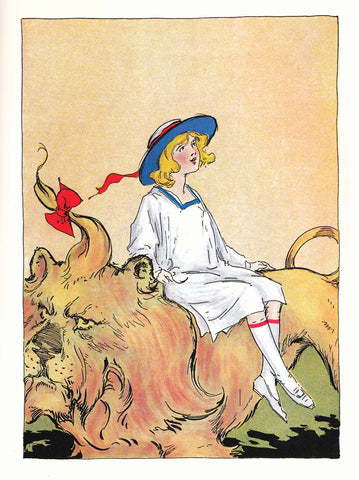 VISIT
MUSEUM STORE
MEMBERSHIP
OZ NEWS
CONTACT
VISIT
MUSEUM STORE
MEMBERSHIP
OZ NEWS
CONTACT
ACH! DU LIEBER OZ!



Wamego#38
Mar 6, 2015 – ACH! DU LIEBER OZ!
[At left and center: The front and rear covers of the 2009 Warner Home Video disc packaging for the first Blu-ray edition of Metro-Goldwyn-Mayer’s THE WIZARD OF OZ (1939), distributed and sold in Germany. As indicated in the account below, OZ was shown in English -- with German subtitles -- during its recent appearance at The Berlin Film Festival. But there also are film prints with the dialogue overdubbed in German; thus this home video version and its title, DER ZAUBERER VON OZ. At right: The cover of the mini-coffee table book that accompanied the 2009 release. In translation, it reads BEHIND THE SCENES OF PRODUCTION 1060. (Those four digits represent the numerical, book-keeping code assigned to OZ by MGM in 1938.) The entire text of the booklet is presented in German.]
-------------
Earlier this winter, I was rereading Peter Filichia’s fine book, STRIPPERS, SHOWGIRLS, AND SHARKS: A VERY OPINIONATED HISTORY OF THE BROADWAY MUSICALS THAT DID NOT WIN THE TONY AWARD (New York: St. Martin’s Press, 2013). He covers the saga of WICKED across pages 85-90, and eventually cites some of the show’s record-breaking, box-office magic during the first nine years of its New York run. It’s still going strong, by the way – both on Broadway and on tour – and has tallied a world-wide gross of over three billion dollars. (And counting!) In keeping with his thesis, Filichia then acknowledges that all of this achievement stands in the face of the fact that WICKED did, indeed, lose the “Best Musical” citation from The American Theatre Wing to AVENUE Q in 2004.
He goes on to ask: “So without a Best Musical Tony and [with] some nagging problems in its book and songs, how has WICKED done so exceptionally well?” For Filichia, there’s a simple summation that answers that question, and he ends his account of the production as he opened it: “Decades ago, longtime Broadway observer Howard Gradet postulated a theory: One cannot go forty-eight hours without running into a reference from [the 1939 MGM film] THE WIZARD OF OZ.” Filichia concludes that WICKED achieved and sustains its success – in good part – “because none of us can go forty-eight hours without being reminded of THE WIZARD OF OZ” – and that audiences avail themselves of WICKED “to be near it once again.”
Needless to say, I’m someone who much appreciates and endorses such analysis, although I’ve now seen WICKED three times and definitely enjoy it, as well, on its own merits. But Filichia’s reflection about a general, genuine audience desire to “be near” Metro’s film classic “once again” was brought home to me last month in an email I received from a friend of fifty-one years' acquaintance. ‘Twas a chance meeting and Judy Garland fandom that brought us together in 1964, and the association has endured and flourished ever since. A fellow native of Wisconsin (where we first aligned), John Walther has taught English in Hamburg, Germany, for decades. Over the weekend of February 14th, he trekked to Berlin to see a special screening of THE WIZARD OF OZ, offered in a film series' retrospective of Technicolor motion pictures in connection with the Berlinale (Berlin Film Festival). I so-much relished his informal report about that event, I asked for permission to post it here, virtually as soon as he sent it. But THE WONDERFUL WORLD OF OZ blog then was in the midst of its three-part Margaret Hamilton “memoir,” and it seemed best not to interrupt that thread.
So, with a few weeks’ delay – and with John’s gracious permission -- here it is now: His description of last month’s occasion, when he took a special trip, just to avail himself of the opportunity “to be near” THE WIZARD OF OZ once again….
-----------------------------------------
It was a wonderful experience....
The theater was not a commercial one; we saw OZ in the screening room of an old museum on the main drag. It's customarily used for special showings of films. It seats about 200 people, and the audience consisted of mostly younger folk, along with a handful of children. As we were waiting to go in, I heard a young man on his cell phone, telling a friend that he was about to see an old Hollywood classic, something "old-fashioned."
The cinema was sold out, and about fifty people had to be turned away. There was a pleasant gentleman organizing everything, who kindly asked people to move into the center of the rows to make it easier for late-comers to be seated. At one point, he asked for a show of hands from anyone who had a free seat next to them.
When it was time for the film to start, this man went up front with a microphone and welcomed everyone in English and in German. He then told us that we were going to see a Hollywood classic directed by Victor Fleming -- and that it was one of the most famous films ever made. (I liked that.)
The lights went down, and that marvelous overture started. It was so grand to see the film on the screen; they were using a 35mm print, which they said they had received from Eastman House. The quality of the print wasn't terribly good -- rather grainy -- but that didn't disturb me; it reminded me of the way we watched it on television as children. And it brought back an endless muddle of memories and emotions of the U.S and childhood and Wisconsin and Christmas and family.
There were so many details that jumped out that I had never noticed before, not even with our pristine DVDs.
I was aware of something in watching this film -- that I was watching it with a group of people for most of whom it was a brand new experience. The cult status of the film in the U.S. is unknown here. Some of them might have seen it on TV at some point, but that would have been it.
The audience didn't make a sound throughout. They were focused on the film. No one sneezed or coughed or rustled candy bar paper. The film was shown in English with German subtitles, which they informed us afterwards were being fed "live" onto the screen with the use of a second projector. I thought the translations were excellent. They didn't try to make poetry out of the complex and sophisticated lyrics in the score -- it was just straight-forward German. This made it possible for the people to appreciate everything and laugh at the right moments. And they laughed a lot. The Cowardly Lion got a big laugh when he appeared.
It was such a valuable experience for me. The film is a gem! (I act as if I had just discovered it for the first time, which in a way, I did.)
I cried through the whole last part of the film, starting when she says goodbye to her three friends. I hoped that no one would notice me shaking, but didn't really care if they did.
At the conclusion, there was an extended burst of applause from the audience. Although I generally think it's a bit absurd to applaud in a cinema, I could feel that the people had been moved and had to express it. We were impressed, as well, by the length of the applause.
-----------------------------------------------
[I thought that very much worth the sharing! And here’s one more expression of gratitude to my cherished friend, John!]
Article by John Fricke



